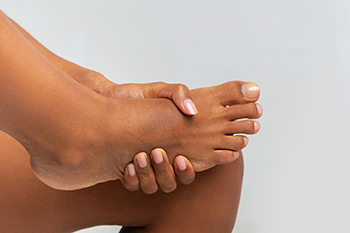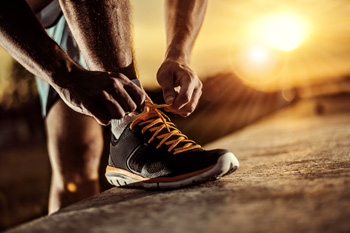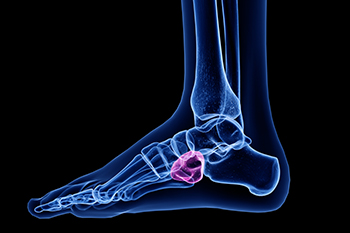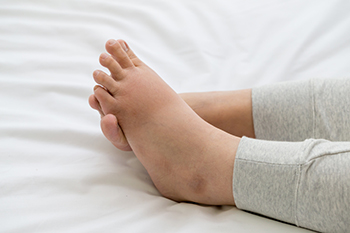Items filtered by date: April 2023
Foot Injuries and Jumping Rope

Jumping rope can be an exciting and exhilarating activity. Nostalgic for some and physically challenging for others, jumping rope is an activity that many can enjoy. However, if one is not careful, jumping rope can lead to a foot injury. For example, if you are not jumping rope on the right surface, then injury can result. Some individuals might jump rope on hard surfaces like concrete, leading to shin splints. Rather, you might consider jumping rope on a surface that offers more shock absorption. This will ultimately put less stress on the joints of the feet as well. If you are someone that exercises by jumping rope, then it is suggested that you schedule an appointment with a podiatrist today for advice and treatment.
Exercising your feet regularly with the proper foot wear is a great way to prevent injuries and build strength. If you have any concerns about your feet, contact Cory Brown, DPM from Cory Brown, DPM. Our doctor can provide the care you need to keep you pain-free and on your feet.
Exercise for Your Feet
Exercise for your feet can help you gain strength, mobility and flexibility in your feet. They say that strengthening your feet can be just as rewarding as strengthening another part of the body. Your feet are very important, and we often forget about them in our daily tasks. But it is because of our feet that are we able to get going and do what we need to. For those of us fortunate enough to not have any foot problems, it is an important gesture to take care of them to ensure good health in the long run.
Some foot health exercises can include ankle pumps, tip-toeing, toe rises, lifting off the floor doing reps and sets, and flexing the toes. It is best to speak with Our doctor to determine an appropriate regimen for your needs. Everyone’s needs and bodies are different, and the activities required to maintain strength in the feet vary from individual to individual.
Once you get into a routine of doing regular exercise, you may notice a difference in your feet and how strong they may become.
If you have any questions please feel free to contact our office located in Lewiston, ID . We offer the newest diagnostic and treatment technologies for all your foot and ankle needs.
Reminder: When Was the Last Time...?
Many Types of Running Shoes to Consider

There are numerous types of running shoes, and it is helpful to determine what kind of running will be practiced before purchasing shoes. Running injuries may be prevented when shoes are rotated, which helps protect the feet. Research has shown it is best when running shoes are bought based on user criteria. These can include choosing the surface that will be run on, understanding your walking style or gait, and examining any running goals. There are several different types of running shoes. Trail shoes can provide extra protection while running in mud, snow, or rough terrain. Conversely, road shoes are designed for treadmills, tracks, and sidewalks. Important qualities to look for in purchasing running shoes involve adequate stability and motion control. If you are interested in buying running shoes, it is suggested that you consult with a podiatrist who can guide you toward choosing the correct pair.
You should always make sure your running shoes fit properly in order to avoid injury. For more information, contact Cory Brown, DPM from Cory Brown, DPM. Our doctor can provide the care you need to keep you pain-free and on your feet.
Choosing the Right Running Shoe for Your Foot Type
Improper shoe sizing can cause a myriad of problems for your feet. Shoes that don’t fit you properly can lead to muscular imbalances in your body, which can result in foot, knee, and hip injuries.
Tips for Finding the Right Running Shoe
- Make sure you have a thumb’s width of wiggle room between the end of your longest toe and the front of the shoe.
- There should be little to no slipping at the heel
- Don’t assume your size in one shoe brand will be your size in another
- Do not lace up your shoes too tightly
- Walk around in the store with your new shoes before you buy them
If you have any questions please feel free to contact our our office located in Lewiston, ID . We offer the newest diagnostic and treatment technologies for all your foot and ankle needs.
Cuboid Syndrome Risk Factors

Although cuboid syndrome may not be as well-known as conditions such as plantar fasciitis to novices to the field of podiatry, it is still a widespread foot condition that is important to be aware of. Cuboid syndrome can develop in an individual when the cuboid bone, located on the outside of the center of the foot, moves out of alignment. As a result, a patient may experience some amount of pain. There are several risk factors that are associated with cuboid syndrome, which may make an individual more predisposed to developing the condition. Namely, being overweight can increase one’s chance of developing cuboid syndrome. Also, spraining the foot or training on surfaces that are uneven can increase the risk of cuboid syndrome. Additionally, wearing ill-fitting shoes can make cuboid syndrome more likely. If you believe that you might have cuboid syndrome, it is suggested that you contact a podiatrist today for treatment.
Cuboid syndrome, also known as cuboid subluxation, occurs when the joints and ligaments near the cuboid bone in the foot become torn. If you have cuboid syndrome, consult with Cory Brown, DPM from Cory Brown, DPM. Our doctor will assess your condition and provide you with quality foot and ankle treatment.
Cuboid syndrome is a common cause of lateral foot pain, which is pain on the outside of the foot. The condition may happen suddenly due to an ankle sprain, or it may develop slowly overtime from repetitive tension through the bone and surrounding structures.
Causes
The most common causes of cuboid syndrome include:
- Injury – The most common cause of this ailment is an ankle sprain.
- Repetitive Strain – Tension placed through the peroneus longus muscle from repetitive activities such as jumping and running may cause excessive traction on the bone causing it to sublux.
- Altered Foot Biomechanics – Most people suffering from cuboid subluxation have flat feet.
Symptoms
A common symptom of cuboid syndrome is pain along the outside of the foot which can be felt in the ankle and toes. This pain may create walking difficulties and may cause those with the condition to walk with a limp.
Diagnosis
Diagnosis of cuboid syndrome is often difficult, and it is often misdiagnosed. X-rays, MRIs and CT scans often fail to properly show the cuboid subluxation. Although there isn’t a specific test used to diagnose cuboid syndrome, your podiatrist will usually check if pain is felt while pressing firmly on the cuboid bone of your foot.
Treatment
Just as the range of causes varies widely, so do treatments. Some more common treatments are ice therapy, rest, exercise, taping, and orthotics.
If you have any questions, please feel free to contact our office located in Lewiston, ID . We offer the newest diagnostic and treatment technologies for all your foot care needs.
Various Reasons Feet Can Swell

Swollen feet can be uncomfortable. It can be common among pregnant women or from an underlying health condition. These can consist of heart failure, kidney disease, or venous insufficiency. Additionally, many people notice their feet may become swollen after eating salty foods or after standing or sitting for extended periods. One of the reasons that swollen feet may cause discomfort is a result of stretched skin. This can lead to wounds that may develop from the skin tearing and may become infected. Effective relief methods may include limiting foods with large amounts of sodium and increasing mobility daily. Some people find it helpful to wear compression socks, which may prevent fluid from collecting in the feet and ankles. If you have swollen feet, it is suggested that you are under the care of a podiatrist who can help you to manage this condition.
Swollen feet can be a sign of an underlying condition. If you have any concerns, contact Cory Brown, DPM of Cory Brown, DPM. Our doctor can provide the care you need to keep you pain-free and on your feet.
Swollen feet are a common ailment among pregnant women and people who stand or sit for extended periods. Aging may increase the possibility of swollen feet and patients who are obese often notice when their feet are swelling too. There may be medical reasons why swollen feet occur:
- Phlebitis - A condition that causes the veins to become inflamed and can also cause leg pain.
- Liver disease - This may lead to low blood levels of albumin which is a protein. This can cause fluid in the blood to pass into the tissues and several areas of the body can become swollen.
- Heart failure - When the heart doesn’t pump properly the blood that is normally pumped back to the heart can pool in the veins of the legs causing swollen feet.
- Kidney disease - One of the main functions of the kidneys is releasing excess fluid in the body. This type of condition can make it difficult for the kidneys to function properly, and as a result the feet may become swollen.
- Deep-vein thrombosis (DVT)- This is a serious condition where blood clots form in the veins of the legs. They can block the return of blood from the legs to the heart which may cause the feet to swell. It is important to be treated by a podiatrist if this condition is present.
Swollen feet can also be caused by bone and tendon conditions, including fractures, arthritis, and tendinitis. Additionally, there may be skin and toenail conditions and an infection may cause the feet to swell. Patients who take medicine to treat high blood pressure may be prone to getting swollen feet.
Many patients elevate their feet to help relieve the swelling and this is generally a temporary remedy. When a podiatrist is consulted the reason behind the swelling can be uncovered and subsequently treated.
If you have any questions please feel free to contact our office located in Lewiston, ID . We offer the newest diagnostic tools and technology to treat your foot and ankle needs.

